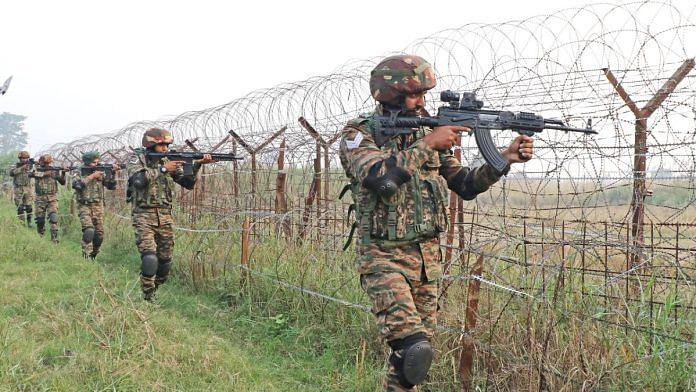Leepa is also one of several points along the LoC, where territorial gains made in the 1971 war allowed India to inflict significant damage on Pakistani military outposts. As Indian military planners contemplate how to impose costs on Pakistan after the Pahalgam massacre, seizing territory in Leepa and elsewhere along the Neelam Valley is one option that is being seriously considered. Like in 2016, Indian troops would mount incursions just hundreds of metres across the LoC—but then hold on to the territory seized.
Even if the territorial gains from such operations can sometimes be measured in centimetres or metres, they inflict material, economic and reputational costs on the Pakistan Army, some Indian military experts argue. Limited in scale and intensity, war on the LoC also has few of the risks of escalation posed by conventional combat in the plains.
There is no predicting if this is the strategy Prime Minister Narendra Modi’s government will pick—but as the pilgrims at Trera know, there’s little permanence to life on the LoC.
Tactical skirmishes—including incursions to seize territory—became a regular feature of the military dynamic on the LoC after 1990, as thousands of jihadists streamed back into Kashmir from training camps run by Inter-Services Intelligence (ISI). The Pakistan Army often provided covering fire to these groups to protect them from Indian ambushes. Indian troops, in turn, responded by firing back at Pakistani outposts or even conducting raids to retaliate against particularly aggressive support for infiltration.
Even though both armies maintained a tradition of silence on these skirmishes, their existence—and savagery—sometimes made their way onto newspaper pages after the Kargil war.
Late in the summer of 2002, as India mobilised its troops along the length of its western borders in the wake of the terrorist attack on Parliament, Pakistani troops captured the on the top of a 3,260-metre peak, overlooking the town of Kel. The intrusion was detected when three soldiers from a battalion of the Sikh Light Infantry, responsible for securing the area, were killed in an ambush.
Four Indian Air Force Mirage 2000 combat jets from the 7 Squadron, backed up by fire from howitzers on the ground, bombarded the positions the Pakistan Army had occupied, and killing 28. This was the first use of air power since the Kargil war and the last before the 2019 strike on Balakot.
Later that year, Pakistani troops attempted to seize unheld areas around the Kangarh post on the LoC in Rajouri. The Pakistani assault team took advantage of gaps in patrolling, which emerged after troops of the 10 Jammu and Kashmir Light Infantry had replaced a unit of the Gurkha Rifles.
The imposition of a ceasefire in 2003, agreed upon during the negotiations between Prime Minister Atal Bihari Vajpayee and Pakistan’s military ruler, General Pervez Musharraf, calmed the tensions. The peace was not permanent, though.
Late in 2012, Reshma Bi, an elderly resident of a hamlet in Uri, crossed the LoC to be with her sons, both fugitives who had fled to Pakistan to evade police cases for cross-border trafficking. Aware that her escape revealed weaknesses in its three-layer border fence, the 19 Infantry Division began building in the area. The Indian construction work was met with fire from across the LoC, leading to an attack on the Pakistan Army’s post at Sawan Patra. A Pakistani soldier was killed in this attack.
The Pakistan Army responded by killing and allegedly beheading two Indian soldiers, Lance Naik Sudhakar Singh and Lance Naik Hemraj, in the Krishna Ghati sector.
For both armies, the quiet use of force has sometimes been used to in blood—even when no clear tactical issue was being contested. Following the Kargil war, in January 2000, seven Pakistani soldiers were alleged to have been captured in a raid on a post in the Nadala enclave across the Neelam River. The seven soldiers, wounded in fire, were allegedly tied up and dragged across a ravine running across the LoC. The bodies were returned, according to Pakistan’s complaint, bearing signs of brutal torture.
The raid has been claimed, but not proved, to have marked vengeance for the torture and murder of Captain Saurabh Kalia and five soldiers—sepoys Bhanwar Lal Bagaria, Arjun Ram, Bhika Ram, Moola Ram, and Naresh Singh—of the 4 Jat Regiment, the first Indian soldiers killed in the Kargil war. Post-mortem investigation revealed that the men’s bodies had been burned with cigarette ends and their genitals mutilated.
Later, in 2008, Indian troops were alleged by Pakistan to have beheaded a soldier and carried his head across on 19 June 2008, in the Bhattal sector in Poonch. The killings came two weeks after an attack on the Kranti border observation post near Salhotri village in Poonch, which claimed the lives of 2/8 Gurkha Regiment soldier Jawashwar Chhame.
Then, on 30 August 2011, Pakistan complained that three soldiers, including a JCO, were beheaded in an Indian raid on a post in the Sharda sector across the Neelam Valley in Kel. The attack followed the killing and beheading of two Indian soldiers near Karnah.
Following the massacre of 29 Hindus in the Prankote village by the Lashkar-e-Taiba, were executed at Bandala in the Chhamb sector. The Pakistan Army claimed to have recovered an Indian-made watch from the scene of the carnage, along with a hand-written note which read, “How does your own blood feel?”
Leepa’s relative remoteness and strategic irrelevance—like that of many other places on the LoC—makes it an ideal location for the waging of secret, brutal warfare. The region from Tangdhar to Leepa made up just a footnote in the war of 1971, with both sides seeking only to occupy high ground. The 104 Infantry Brigade, India’s records, essentially seized the heights around Leepa and Tangdhar to secure Kashmir against an attack through the Tutmari Gali. Among the key positions captured was Naukot, overlooking the valley.
Though some gains were made, the effort to further secure the Indian line by capturing posts at Shishaledi, Ziarat and Jamua had to be called off after the ceasefire of 1971.
Even though skirmishes have regularly erupted on the same battlefield over the years, there is a real possibility the Indian Army might now—or in coming months—try to complete the unfinished business of 1971. There is no telling, of course, how significant or durable the gains might be. Though the Pakistan Army might indeed suffer humiliation if the LoC is pushed westward, India’s problems with infiltration would remain. And while a war of attrition might inflict greater costs on Pakistan than India, it could well mean an escalation of terrorism within Kashmir.
The maintenance of the ceasefire on the LoC has been a cornerstone of Indian policy since 2003, as it is critical to containing infiltration by jihadists. Nevertheless, frustration in India has mounted to the point that rolling the dice now seems increasingly attractive to the strategic establishment.
Praveen Swami is contributing editor at ThePrint. His X handle is @praveenswami. Views are personal.
(Edited by Prasanna Bachchhav)








